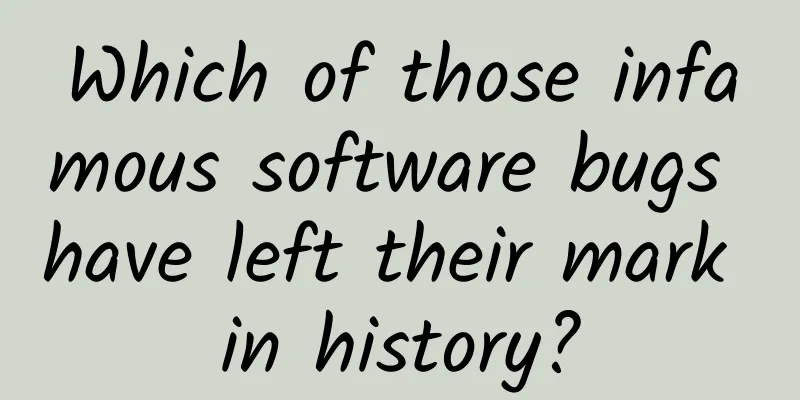Which of those infamous software bugs have left their mark in history?

|
In today's digital age, computer bugs not only bother every programmer, but also inevitably affect our lives, from the daily life of each person to the national economy and the world situation. As our lifestyle gradually becomes digital and internet-based, finding and killing bugs in the digital world becomes more and more important.
What are some famous bugs in software history? Let's review them together: 1. The mother of all insects, a name left in history (The first bug in software history) At 3:45 pm on September 9, 1947, Grace Murray Hopper recorded the first computer bug in her notebook - a moth found in the Harvard Mark II computer. She pasted the moth on her notebook and wrote "First actual case of bug being found". This discovery established the status of the word "bug" in the computer world and became the nightmare of countless hard-working programmers. Since then, the word "bug" in the computer world refers to errors or omissions in computer programs, which can cause the program to calculate inexplicable results or even cause the program to crash. Grace Murray Hopper was one of the earliest programmers in history, and she was also a female programmer. She served in the US Navy and was promoted to brigadier general. This is the most widely circulated story about computer bugs, but the historical truth is that the word "bug" was widely used to refer to machine failures as early as the time of inventor Thomas Edison, which can also be seen in Edison's own notes around 1870. The Institute of Electrical and Electronics Engineers (IEEE) also attributes the introduction of the word "bug" to Edison. 2. Y2K, a carnival of hype (In 1999, it provided excellent material for sensationalist magazines and tabloids) In the last century, software developers never thought that their codes and products would enter the new millennium. Therefore, in order to save memory, many software developers omitted the first two digits of the year, "19", or assumed the first two digits to be "19". As the calendar got closer to December 31, 1999, people became increasingly concerned that everyone's computer systems would crash on New Year's Eve of the millennium because the system date would be updated to January 1, 1900 instead of January 1, 2000, which could mean countless catastrophic events or even the end of the world. To this day, we can laugh at this ridiculous story because nuclear missiles did not launch automatically, planes did not fall out of the sky out of control, and banks did not lose large amounts of deposits of the country and its users. The Y2K bug was real, and the world spent hundreds of millions of dollars upgrading systems. In addition, some minor incidents occurred:
3. Dhahran missile incident, millisecond error During the first Gulf War in February 1991, a Scud missile launched by Iraq accurately hit the U.S. Dhahran base in Saudi Arabia, killing 28 American soldiers on the spot and injuring more than 100 people. This was the only time in the Gulf War that the U.S. military suffered more than 100 casualties. Later investigations revealed that a simple computer bug had caused the Patriot anti-missile system at the base to fail and fail to intercept the Scud missile in mid-air. At the time, the Patriot anti-missile system responsible for defending the base had been working for 100 hours in a row. Every hour of work, the clock in the system would have a tiny millisecond delay, which was the root cause of the failure tragedy. The clock register of the Patriot anti-missile system was designed to be 24 bits, so the time accuracy was limited to 24 bits of accuracy. After a long period of work, this tiny precision error was gradually magnified. After working for 100 hours, the system time delay was one-third of a second. To the average person, 0.33 seconds is insignificant. But for a radar system that needs to track and destroy a missile in the air, it is catastrophic - the Hussein Scud missile has an airspeed of Mach 4.2 (1.5 kilometers per second), and this "insignificant" 0.33 seconds is equivalent to an error of about 600 meters. In the Dhahran missile incident, the radar detected the missile in the air, but due to the clock error, it was not able to accurately track it, so the base's anti-missiles did not launch. (Dhahran missile incident illustration) 4. Meters or Feet? Mars Climate Orbiter's Star Trek The Mars Climate Orbiter was launched in 1997 to study the Martian climate, but it failed to achieve its $300 million-plus mission. After flying in space for several months, the probe eventually disintegrated in the Martian atmosphere due to a navigation error. The probe's control team used imperial units to send navigation instructions, while the probe's software system read the instructions in metric units. This error greatly changed the path of navigation control. Finally, the probe entered a too low Martian orbit (about 100 kilometers error) and disintegrated under the excessive Martian atmospheric pressure and friction. (Meters or feet? Off by 100 kilometers!) Ariane 5 launch vehicle, an expensive simple copy When programming, programmers must define the variables used by the program and the computer memory required for these variables, which is defined in bits. A 16-bit variable can represent values between -32.768 and 32.767, while a 64-bit variable can represent values between −9.223.372.036.854.775.808 and 9.223.372.036.854.775.807. On June 4, 1996, after the first launch of the Ariane 5 rocket, the rocket began to deviate from its course and was eventually forced to detonate and self-destruct. The whole process took only 30 seconds. The Ariane 5 rocket was developed based on the previous generation of the Ariane 4 rocket. In the Ariane 4 rocket system, a 16-bit variable and memory were used for the measurement of a horizontal rate. Because it was repeatedly verified in the Ariane 4 rocket system that this value would not exceed the 16-bit variable, the developers of the Ariane 5 rocket simply copied this part of the program without verifying the value of the new rocket, resulting in a fatal numerical overflow. After the launch, this 64-bit variable with a decimal point was converted into a 16-bit variable without a decimal point, triggering a series of errors, which affected all the computers and hardware on the rocket and paralyzed the entire system, so it had to choose to self-destruct, and 400 million US dollars turned into a huge firework. (Ariane 5 fireworks cost $400 million, produced by software bug) Easter egg: Windows 98 Blue Screen of Death (Bill Gates witnessed the Blue Screen of Death with the audience at the Windows 98 live demonstration) |
<<: Where has the time gone? The classic software that was popular in those years
>>: If you want to be a full stack engineer
Recommend
The sample adulteration rate is as high as 83%. Is your silk quilt "authentic"?
A new year, a new beginning, and a new big speech...
A guide to avoiding pitfalls in overseas marketing
How popular are brands going overseas? According ...
Christopher Meng's "Intimacy: A Bridge to the Soul" Audiobook + In-depth Interpretation
Christopher Meng's "Intimate Relationshi...
These 5 most common household items are actually extremely dirty! (No. 4 is used by everyone)
Everyone has different habits when it comes to cl...
Event operation and promotion, 6 common ways to play with red envelopes!
Red envelopes are one of the common marketing met...
Why is the silver bracelet ineffective in testing poison?
Recently, a man in Yibin, Sichuan, picked mushroo...
EK releases Intel 750 hard drive water cooling head
HDD mechanical hard disks use high-speed motors, ...
Brand promotion: Brand media placement methodology!
The growth of every brand is inseparable from med...
Alipay APP changes its icon: 2021 "Collect Five Blessings" is here, with more ways to play this year
There is less than a month left until the 2021 Sp...
Apple may remit funds to Chinese developers at a 1:1 exchange rate between RMB and USD
[[275889]] Several Chinese iOS developers said on...
Is The Division shrinking or disconnecting? A full experience of The Division on PS4
When talking about Ubisoft, the first thing that ...
Natural history on the tip of your tongue, taste the culture and knowledge about food
Experience the culture and knowledge about food, u...
Product Operations: How to develop a growth strategy for a product?
After the concept of growth hacking was introduce...
Can instant noodles really have a 12-month shelf life? How can we prevent free radicals like viruses?
Recently, the media interviewed the following que...









